Daily overview — Summary report, November 26
A map of the approximate situation on the ground in Ukraine as of 00:00 UTC 26/11/22.
— War Mapper (@War_Mapper) November 26, 2022
There have been no notable changes to control since the last update. pic.twitter.com/Ol6m0Xo9Sa
The General Staff’s operational update regarding the Russian invasion as of 06.00 am, November 26, 2022 is in the dropdown menu below:
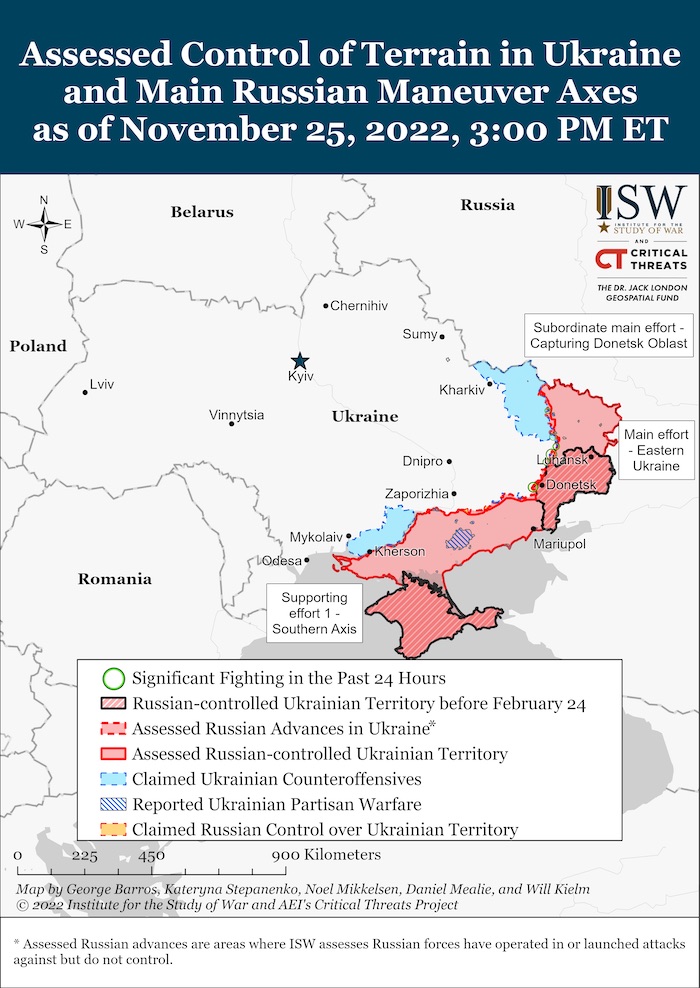
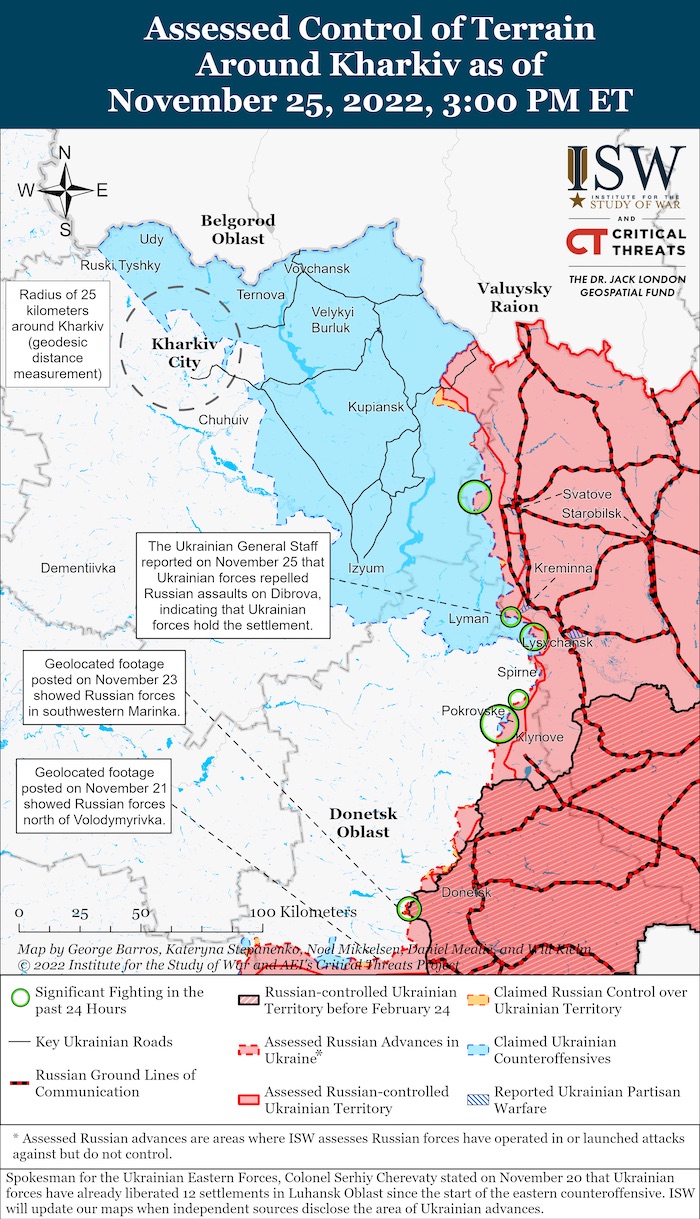
- In the Slobozhanskyi direction, Russian forces carried out artillery fire on the areas of Kozacha Lopan, Strilecha, Lypka, Starytsa, Ohirtseve and Dvorichna settlements of the Kharkiv oblast.
- On the Kupiansk and Lyman directions, Russian forces are conducting an active defence, shelling the areas of the settlements of Kupiansk, Berestove, Kislivka and Tabaivka of the Kharkiv oblast with tanks and artillery; Stelmakhivka, Makiivka and Ploshchanka in the Luhansk oblast and Yampolivka and Torske in the Donetsk oblast.
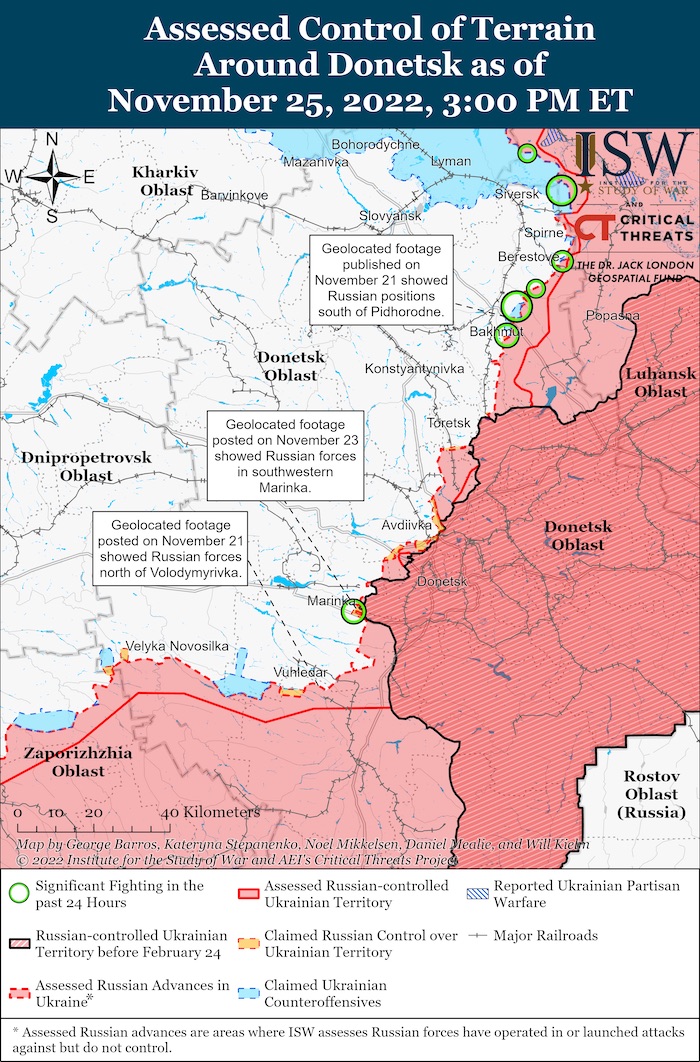
- In the Bakhmut and Avdiivka directions, the occupiers continue to focus their main efforts on conducting offensive actions. Shelling was recorded in the areas of Soledar, Bakhmutske, Bakhmut, Klishchiivka, Krasnohorivka, Vesele, Avdiivka, Opytne, Vodyane, Nevelske and Mariinka settlements of Donetsk oblast.
- Russian forces are conducting active defensive operations in the Novopavlivsk and Zaporizhzhia directions. Fired tanks and the entire range of artillery in the areas of the settlements of Vuhledar, Prechystivka, Neskuchne, Vremivka, Novopil, Zelene Pole of the Donetsk oblast and Olhivske, Hulyaipole, Hulyaipilske and Charivne in Zaporizhzhia oblast.
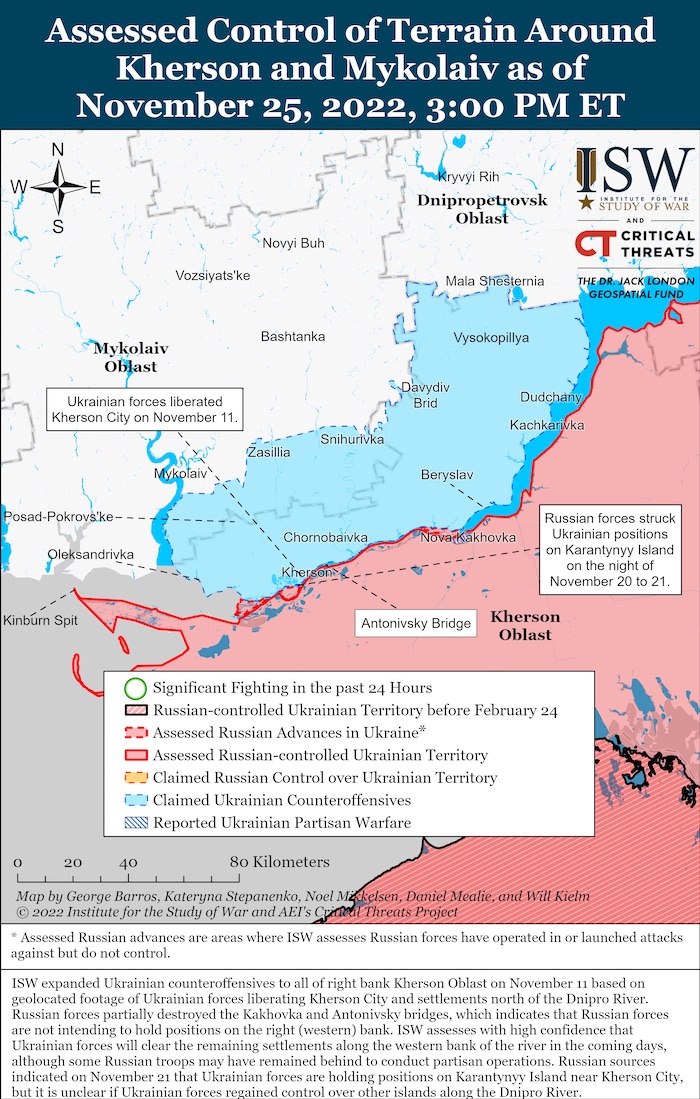
- In the Kryvyi Rih and Kherson directions, Russian forces are carrying out fortification of positions along the coastline and in the depth of the defence, improving the logistical support of advanced units, and does not stop artillery shelling of the positions of our troops and settlements on the right bank of the Dnipro River. The cities of Ochakiv and Kherson were directly affected by enemy fire.
Military Updates
Russians go ballistic after ammunition depot is blown up in occupied Mykhailivka, Ukrainska Pravda reports, citing Ivan Fedorov, Mayor of Melitopol. “On Friday morning, a Russian ammunition depot was blown up in the village of Mykhailivka, Zaporizhzhia Oblast, after which the invaders began to take a large number of locals prisoner.” No Russian ships equipped with missiles are on duty in the Black and Azov Seas yet, Ukrainska Pravda reports, citing the Ukrainian Navy. "There are 11 enemy ships on combat duty in the Black Sea; Russian forces continue to control sea communications keeping 2 ships on combat duty in the Azov Sea." According to the infographics provided by the Navy, there are no 3M-54 Kalibr cruise missile carriers on these ships. At the same time, ships equipped with missiles are on duty only in the Mediterranean Sea.”According to British Defence Intelligence, (last 48 hours):
https://twitter.com/DefenceHQ/status/1596123615313145857- Russia is likely removing the nuclear warheads from ageing nuclear cruise missiles and firing the unarmed munitions at Ukraine. Open source imagery shows wreckage of an apparently shot-down AS-15 KENT air launched cruise missile (ALCM), designed in the 1980s exclusively as a nuclear delivery system. The warhead had probably been substituted for ballast.
- Although such an inert system will still produce some damage through the missile's kinetic energy and any unspent fuel, it is unlikely to achieve reliable effects against intended targets. Russia almost certainly hopes such missiles will function as decoys and divert Ukrainian air defences.
- Whatever Russia's intent, this improvisation highlights the level of depletion in Russia's stock of long-range missiles.
- Two months after President Putin announced a ‘partial mobilisation’, common themes are emerging in the experience of mobilised Russian reservists. Their deployment is often characterised by confusion over eligibility for service, inadequate training and personal equipment, and commitment to highly attritional combat missions.
- Most - though not all - mobilised reservists have previously served and numerous examples suggest that reservists are highly likely not having their medical status adequately reviewed and many are being compelled to serve with serious, chronic health conditions.
- Mobilised reservists have highly likely experienced particularly heavy casualties after being committed to dig ambitious trench systems while under artillery fire around the Luhansk Oblast town of Svatove. In Donetsk Oblast, reservists have been killed in large numbers in frontal assaults into well-established Ukrainian defensive zones around the town of Bakhmut. The Kremlin will likely be concerned that an increasing number of reservists’ families are prepared to risk arrest by protesting against the conditions their relatives are serving under.
Losses of the Russian army
As of Saturday 26 November, the approximate losses of weapons and military equipment of the Russian Armed Forces from the beginning of the invasion to the present day:- Personnel – about 86710 (+560),
- Tanks – 2901 (+2),
- Armoured combat vehicles – 5848 (+4),
- Artillery systems – 1896 (+1),
- Multiple rocket launchers –MLRS - 395 (+0),
- Air defence means – 209 (+0),
- Aircraft - 278 (+0),
- Helicopters - 261 (+0),
- Automotive technology and fuel tanks – 4406 (+2),
- Vessels/boats - 16 (+0),
- UAV operational and tactical level – 1554 (+1),
- Special equipment – 163 (+0),
- Mobile SRBM system – 4 (+0),
- Cruise missiles – 531 (+0)
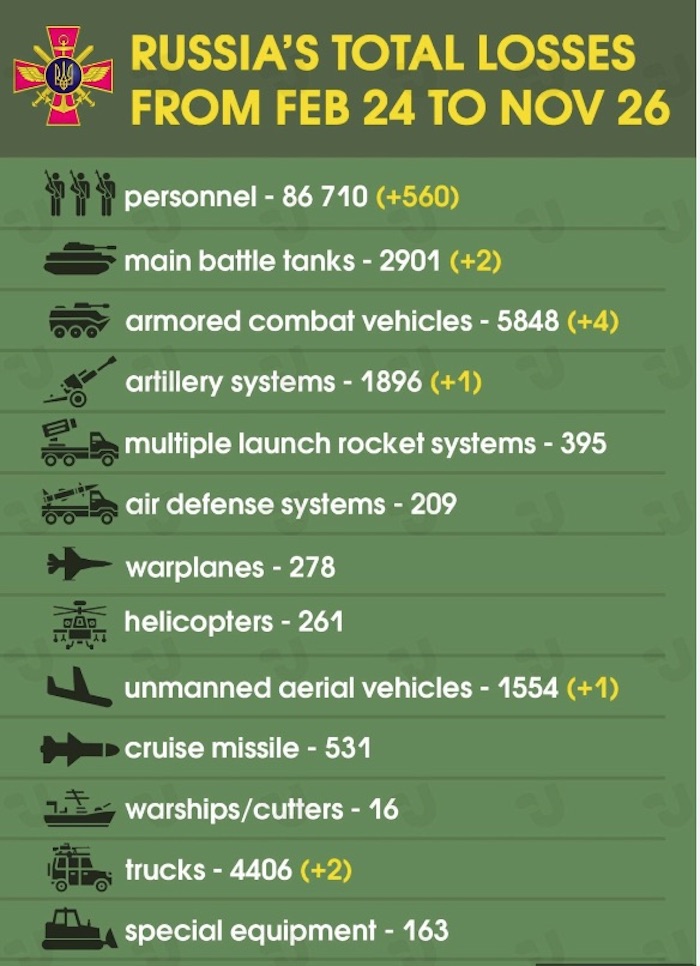
Humanitarian
UN rights boss says Russian strikes plunge millions into hardship, Reuters reports. “The UN human rights chief said on Thursday that Russian strikes on critical infrastructure in Ukraine since October had killed at least 77 civilians and were plunging millions of people into extreme hardship. Much of the country remained without heat or power after the most devastating Russian air strikes on its energy grid so far. Since early October, Russia has launched missiles roughly once a week in a bid to destroy the Ukrainian power grid. Moscow acknowledges attacking basic infrastructure but denies it targets civilians, saying it aims to reduce Ukraine's ability to fight and push it to negotiate. Kyiv says such attacks are a war crime. Millions are being plunged into extreme hardship and appalling conditions of life by these strikes said Volker Turk in a statement. Taken as a whole, this raises serious problems under international humanitarian law, which requires a concrete and direct military advantage for each object attacked."More than 70% of Ukraine’s electricity needs are covered, Ukrainska Pravda reports, citing the press service of Ukrenergo [Ukrainian national energy company]. “Thus, first of all, electricity was supplied to boiler houses, gas distribution stations, water utilities, and sewage treatment plants. Public electric transport is working in some oblasts. Nuclear power plants continue to gain capacity, and in addition, the power supply of the Zaporizhzhia NPP was ensured. Despite the damage caused by the missile attacks, thermal and hydroelectric power plants, combined heat and power plants, and a part of the "green" energy generation facilities have been put into operation. Ukrenergo notes that work continues to restore power to household consumers, but difficult weather conditions slow down the pace of restoration. Due to strong winds, rain, and sub-zero temperatures at night, the damage caused by the Russian missiles is accompanied by icing and broken wires in distribution networks. The system still has an electricity deficit. Currently, it is 30% of the total consumption. In this regard, both planned and emergency consumption restriction schedules have been implemented in all oblasts of Ukraine.” Numbers of consumers affected by blackout halved – Zelenskyy, Ukrainska Pravda reports, citing President Zelenskyy. "Between Wednesday and today [Friday], we were able to halve the number of people for whom electricity has been cut off in order to stabilise the system. As of this evening, blackouts continue in most regions and Kyiv. In total, more than six million consumers [are affected]. On Wednesday, almost 12 million subscribers were cut off from the grid. The capital of Ukraine is seeing the most problems at the moment, as well as in the Kyiv, Odesa, Lviv, Vinnytsia and Dnipropetrovsk oblasts.”Julien is from France and lives in #Odesa. He's a teacher and now has to give online lessons from cafes.
— Euromaidan Press (@EuromaidanPress) November 25, 2022
"It gets hard but I hope for the best. People are strong and don't give up. They will fight. They won't let Russians enter the city."
And, music and art in the main street. pic.twitter.com/nLUJy5x5Q4
Life in liberated Kherson: euphoria, blackout and Russian bombs.
— Euromaidan Press (@EuromaidanPress) November 25, 2022
The report by a Kherson-based journalist @IvAnt_21 from the unbreakable Ukrainian city that refuses to trade freedom for warm batteries.https://t.co/qY4odc6pdb
Environment
Ukraine's four nuclear power plants reconnected to the grid – IAEA, Reuters reports. “Ukraine's four nuclear power plants have been reconnected to the national power grid after completely losing off-site power earlier this week, the International Atomic Energy Agency said on Friday. The facilities were all disconnected from the grid on Wednesday for the first time in Ukrainian history after the latest wave of Russian air strikes on vital infrastructure. In a statement, the IAEA nuclear watchdog said Ukraine had informed it on Friday that its Rivne, South Ukraine and Khmelnytskyy plants had been reconnected. Ukraine reconnected its vast Zaporizhzhia plant on Thursday, Kyiv said earlier. The Zaporizhzhia plant, which was seized by Russia in the early phase of its Feb. 24 invasion, was shut down in September, but still needs electricity to keep up essential safety work.”️Legal
440 children were killed, 849 children injured, 11,461 deported by foe forces, and 329 reported missing - the Office of the Prosecutor General of Ukraine reports as of November 26. 2,719 educational establishments are damaged as a result of shelling and bombings, and 332 of them are destroyed fully. 49,471 crimes of aggression and war crimes and 19,139 crimes against national security were registered.Support
Some nations send Ukraine weapons secretly – Kuleba, Ukrinform reports, citing the Ministry of Foreign Affairs of Ukraine. “Some countries provide military aid to Ukraine, although they do not talk about it and even deny their participation. In these cases, Ukraine receives weapons via third countries, not directly. Minister of Foreign Affairs of Ukraine Dmytro Kuleba says partners not only transfer their own weapons but also work with third countries, buying equipment from them before forwarding it to Ukraine. Most of these third countries publicly say that they are supplying nothing, but things are happening behind the scenes, he noted. […] As Ukrinform reported earlier, as a result of negotiations with the American government, the Israeli authorities transferred millions of dollars for the purchase of "strategic equipment" for Ukraine. In October, Israel provided Ukraine with intelligence to be used for downing Iranian-made one-way attack drones.” Germany in talks with allies over Polish push for Patriot deployment to Ukraine, Reuters reports. “Germany said on Friday it was discussing with allies Poland's request that German Patriot air defence units be sent to Ukraine after NATO's chief suggested the military alliance might not oppose such a move. […] Berlin offered Warsaw the Patriot system to help secure its airspace after a stray missile crashed and killed two people in Poland last week. Polish Defence Minister Mariusz Blaszczak later asked Germany to send the fire units to Ukraine instead. NATO Secretary-General Jens Stoltenberg said such deployments should be decisions for individual nations, taking into account rules around final users. […] Stoltenberg's comments came after German Defence Minister Christine Lambrecht on Thursday said sharing Germany's Patriot units outside NATO territory would require prior discussions with NATO and the allies. […] On Friday, the Polish president said it was Germany's decision where its Patriot air defence units are stationed, adding that it would be better for Poland's security if they were on Ukrainian territory near the border. […] Duda later said that Germany could send the Patriot units to Ukraine without NATO troops to operate them, something he says Kyiv has been asking for for a while.” The US deploys in Poland repair base for Ukraine’s artillery – media, Ukrinform reports, citing The New York Times. “The Pentagon has set up on the territory of Poland a repair point for Western artillery weapons supplied to Ukraine. Sources in American defence agencies say a third of the Western-made howitzers handed over to Ukraine are currently [out] of service. Given the existing problems with repairing artillery on the ground, it has become a priority for the US European Command to address the issue by establishing a repair hub in Poland. The overhaul of such weapons has been going on for months. The condition of weaponry provided to Ukraine is the subject of close attention among US military officials, who declined to discuss details of the program.” Norway allocates $15M for EU military mission in support of Ukraine, Ukrinform reports. “The Government of Norway allocates approximately NOK 150 million ($15.1 million) to the European Union Military Assistance Mission in support of Ukraine (EUMAM Ukraine). This is said in a statement published on the Norwegian government’s website. Ukraine depends on support from other countries, not least to obtain sufficient weapons and materials to stand up to Russian warfare. Norway has provided considerable support and will continue to contribute with donations of military material. It is important for Norwegian and European security that Russia does not win its war against Ukraine. Ukrainian forces are fighting an important battle for democracy and justice, said Minister of Defence Bjørn Arild Gram. In addition, Norway is financing parts of an Estonian donation of a field hospital to Ukraine, as well as donating five military ambulance buses.” https://twitter.com/EuromaidanPress/status/1596160080738656258 EU to provide more help to maintain power and heating in Ukraine, Reuters reports. “The European Union will step up efforts to provide Ukraine with support to restore and maintain power and heating, the head of the European Commission said on Friday, after a new wave of Russian missile attacks on critical Ukrainian infrastructure. Commission head Ursula von der Leyen said in a statement after a phone call with Ukraine's President Volodymyr Zelenskyy the EU executive arm was preparing the delivery to Ukraine large donations from EU countries and from the Commission's reserves. Von der Leyen said the EU would provide 200 medium-sized transformers and a large autotransformer from Lithuania, a medium-sized autotransformer from Latvia and 40 heavy generators from the EU reserve in Romania. Each of these generators can provide uninterrupted power to a small to medium-sized hospital, she said. The European Commission is additionally working on a new energy hub in Poland to allow donations from third parties and help with their delivery to Ukraine in a coordinated fashion, particularly with our G7 partners, she said.” USAID delivers more than 1,000 power generators to Ukraine, Ukrinform reports, citing the US Embassy in Ukraine. “The United States continues to support Ukraine and the Ukrainian people amid Russia’s continuing attacks. With Russia intensifying its attacks against Ukraine’s electricity system, USAID has delivered more than 1,000 power generators to help hospitals, schools, emergency services, government agencies, and other public service providers continue working amid the war, the report says.” https://twitter.com/EuromaidanPress/status/1596175189112496136 Ukrainian Intelligence names global companies that presumably sell chips for Russian missile strikes, Ukrainska Pravda reports, citing the press service of the Defence Intelligence of Ukraine (DIU). “Russia's GLONASS system, which is used to aim missiles and drones, has a weak spot: it depends on microchips produced by foreign companies. Defence Intelligence reports that a number of American and European companies still continue to produce microchips that support Russia's GLONASS: Linx Technologies (USA); Broadcom (USA); Qualcomm (USA); Telit (USA); Maxim Integrated (USA); TRIMBLE (USA); Cavli Wireless (USA); u-blox AG (Switzerland); STMicroelectronics (Switzerland); Sierra Wireless (Canada); NovAtel (Canada); Septentrio (Belgium); and Antenova (Great Britain). Russia, in turn, continues to purchase GLONASS-supporting microchips thanks to numerous shell companies and distributors. They are used in, at least, such weapons as: Orlan-10 and Shahed-136 drones, Tornado-S and Smerch MLRS, Iskander, Kalibr and Kinzhal missiles, as well as Kh-101, Kh-555, Kh-38, Kh-59MK, Kh-31 aviation and cruise missiles. Without foreign-made GLONASS-enabled chips, Russians will have to build their own microelectronics from scratch."EU to intensify supply of generators, transformers to Ukraine - President of EU Commission Ursula von der Leyen
— Euromaidan Press (@EuromaidanPress) November 25, 2022
Ukraine will receive 200 medium-sized transformers from Lithuania, autotransformer from Latvia, &
40 heavy generators from the rescEU reserve https://t.co/7esCe7O57P
New Developments
https://twitter.com/EuromaidanPress/status/1596209699858399234- Russia not looking for peace now, Ukrinform “Russia is now looking not for peace but for respite to continue aggression with new forces. Minister of Foreign Affairs of Ukraine Dmytro Kuleba and British Foreign Secretary James Cleverly made a corresponding statement at a joint briefing in Kyiv, an Ukrinform correspondent reports. […] Recently, the mass media claim that the partners are allegedly pushing Ukraine to premature negotiations with Russia. It is important to note[…] that Russia is not looking for peace right now. It is looking for respite to continue the aggression and destruction of Ukraine and Ukrainians with new forces, Kuleba said.”
- Stoltenberg explains why talks with Russia make no sense today, Ukrinform reports, citing Secretary General Jens Stoltenberg. "There will be no lasting peace if the aggressor wins if oppression and autocracy prevail over freedom and democracy. Most wars end with negotiations but what happens at the negotiating table depends on what happens on the battlefield. Therefore, the best way to increase the chances of a peaceful solution is to support Ukraine. So NATO will continue to stand with Ukraine for as long as it takes. We will not back down, said the General Secretary. He reiterated that the world must not allow Putin to win because otherwise all of us will pay a much higher price, for many years to come."
- Zelenskyy: Solutions that don't involve liberating Crimea are a "waste of time", Ukrainska Pravda reports, citing Zelenskyy in an interviewwith Financial Times. “President Volodymyr Zelenskyy has said he is prepared to consider "non-military means" of returning Crimea under Ukraine’s control, but believes that the options that do not involve liberating the peninsula from Russian occupation a waste of time."
- Kremlin does not like Zelenskyy’s categorical stance on liberating Crimea, Ukrainska Pravda reports, citing Dmitry Peskov, Press Secretary of the Russian President. "You know that since the very beginning and the President [Putin - ed.] has said this multiple times, even before the special operation, the Constitution of Ukraine stated that Crimea should be brought back to Ukraine by military means, by force. And de facto, Ukraine has not given it up, and for us, it is nothing more than a discussion of annexation of the territory of the Russian Federation; there can be no other interpretation here; this is out of the question."
- EU delays talks on Russian oil price cap until next week – diplomats, Reuters “A meeting of European Union government representatives, scheduled for Friday evening to discuss a Group of Seven (G7) proposal to cap Russian seaborne oil prices, was cancelled, EU diplomats said. […]European Union governments were spliton the level at which to cap Russian oil prices to curb Moscow's ability to pay for its war in Ukraine without causing a global oil supply shock. The cap is to enter into force on Dec. 5. The idea of the cap is to prohibit shipping, insurance and re-insurance companies from handling cargoes of Russian crude around the globe, unless it is sold for less than the price set by the Group of Seven nations and its allies.”
- Ukrainian delegation to boycott OSCE Assembly since they could not expel Russia, Ukrainska Pravda “The Permanent Delegation of the Verkhovna Rada of Ukraine to the OSCE Parliamentary Assembly is going to boycott the organisation’s work after its Standing Committee could not change the rules in order to expel Russia. This was reportedby a member of the delegation, Yevheniia Kravchuk (of the Sluha Narodu [Servant of the People] party), as stated by European Pravda.“
- NATO troops hold drills in Poland's Suwalki Gap, Reuters “NATO forces took part in drills in northern Poland on Friday, an area of crucial significance to the security of the alliance's eastern flank. The Suwalki Gap, a sparsely populated area of Polish territory lying between Belarus and the Russian exclave of Kaliningrad, is of strategic importance because its takeover by Russia would isolate the Baltic states from the rest of NATO. […] As part of these drills there were exercises that... were formulated based on our experience and observation of the battlefield in Ukraine, said Polish Defence Minister Mariusz Blaszczak. We know what methods Russia uses and what methods (of defence) are effective."
- Bundestag Ready to Recognise Holodomor as Genocide, European Pravda “The majority of political groups in the German Bundestag have reached an agreement on a joint resolution recognising the Holodomor as a genocide of the Ukrainian people.”
- Soldiers' mothers who met with Putin turned out to be hand-picked from pro-government bodies, Ukrainska Pravda “Vladimir Putin, the president of the aggressor country, supposedly met with the mothers of soldiers fighting against Ukraine on 25 November. An independent news outlet has identified the women who attended the meeting.”
Hungary to ratify NATO membership for Finland & Sweden, Hungarian PM Orban says - CNN
— Euromaidan Press (@EuromaidanPress) November 25, 2022
While all 30 NATO members formally invited the two countries to join the alliance back in the summer, Turkey and Hungary have yet to ratify the accession protocol.https://t.co/gNWZkqYAGf
Assessment
- On the war.
The Institute for the Study of War has made the following assessment as of 25 November, 2022:
- Reports of a group of understaffed and ill-supplied mobilized personnel are dividing the Russian information space.
- President Vladimir Putin falsely presented a meeting with hand-picked women as an open discussion with mothers of mobilized personnel.
- An investigation by Forbes’ Ukrainian service revealed that the war in Ukraine has had a serious financial impact on the Russian Federation’s annual budget.
- The Russian MoD may have increased the frequency of POW exchanges to soothe discontent in the Russian information space.
- A Ukrainian official confirmed that Ukrainian forces killed Iranian military advisors in Russian-occupied Crimea and threatened to target Iranian military presence on Ukrainian territory.
- Russian military leadership may be circulating a document stating that Russia needs to mobilize five million personnel to win the war in Ukraine, which Russia cannot do.
- Russian forces conducted limited counterattacks to regain lost positions northwest of Svatove and Russian sources claimed that Ukrainian forces continued counteroffensive operations toward Kreminna.
- Russian forces continued to conduct offensive operations in the Bakhmut and Avdiivka areas, and influential Russian figures may be setting informational conditions to deflect blame for a lack of progress in the Bakhmut area.
- Russian forces continued to establish defenses south of the Dnipro River in Kherson Oblast and around critical ground lines of communication (GLOCs) connecting Crimea to southern Kherson Oblast.
- Russian sources and officials continue attempts to shape the narrative around a likely second partial mobilization while denying the potential for general mobilization.
- Consequences and what to do?
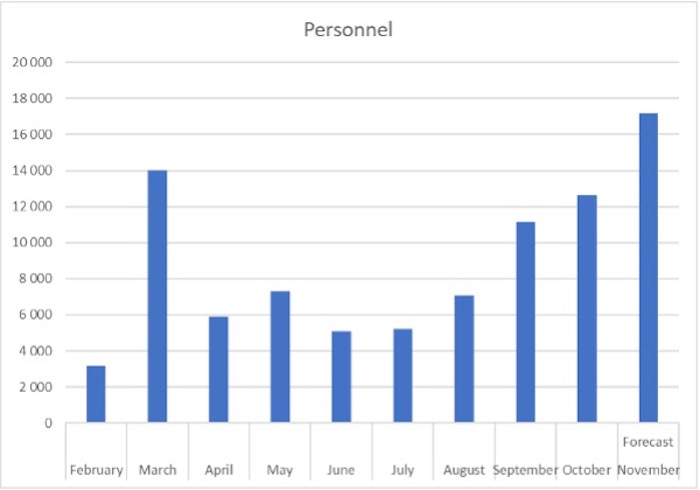 As of 26 November, Russia has according to the Ukrainian Armed Forces lost a staggering 86,710 soldiers and mercenaries in Ukraine. The initial attempt to capture Kyiv resulted in a humiliating retreat and an attempt to focus its efforts on the capture of Donbas. It has lost 74,443 km2 since the peak of its advance.
During the initial part of the invasion, Russia lost a tremendous amount of both personnel and equipment. After the withdrawal from the northern axis, their losses fell substantially until the Ukrainian surprise counteroffensive on 6 September.
While the losses of equipment have slowly fallen since their peak in September and October, the manpower losses have continued to skyrocket. The accelerating loss of soldiers is most likely a direct consequence of the partial mobilisation and their lack of training, equipping and sustainment. According to UK intelligence,
“mobilised reservists have highly likely experienced particularly heavy casualties after being committed to dig ambitious trench systems while under artillery fire around the Luhansk Oblast town of Svatove. In Donetsk Oblast, reservists have been killed in large numbers in frontal assaults into well-established Ukrainian defensive zones around the town of Bakhmut.”
This is just one out of many reports of mobilised personnel being sacrificed in continuous and meaningless Russian attempts to ensure advance at any cost.
As of 26 November, Russia has according to the Ukrainian Armed Forces lost a staggering 86,710 soldiers and mercenaries in Ukraine. The initial attempt to capture Kyiv resulted in a humiliating retreat and an attempt to focus its efforts on the capture of Donbas. It has lost 74,443 km2 since the peak of its advance.
During the initial part of the invasion, Russia lost a tremendous amount of both personnel and equipment. After the withdrawal from the northern axis, their losses fell substantially until the Ukrainian surprise counteroffensive on 6 September.
While the losses of equipment have slowly fallen since their peak in September and October, the manpower losses have continued to skyrocket. The accelerating loss of soldiers is most likely a direct consequence of the partial mobilisation and their lack of training, equipping and sustainment. According to UK intelligence,
“mobilised reservists have highly likely experienced particularly heavy casualties after being committed to dig ambitious trench systems while under artillery fire around the Luhansk Oblast town of Svatove. In Donetsk Oblast, reservists have been killed in large numbers in frontal assaults into well-established Ukrainian defensive zones around the town of Bakhmut.”
This is just one out of many reports of mobilised personnel being sacrificed in continuous and meaningless Russian attempts to ensure advance at any cost.
 The loss of equipment this autumn is partly a reflection of the impact of the initial surprise from the Ukrainian counteroffensive and the consequential Russian rout from the Kharkiv oblast. It is also a reflection of the new dynamics resulting from the Russian withdrawal from western Kherson and the ensuing redeployment of both Ukrainian and Russian forces to other sectors. These forces are most likely still being relocated and prepared for the next offensive. It is not least, also a direct consequence of the weather conditions. Poor conditions and muddy terrain have reduced their ability to manoeuvre their land forces. The deep freeze that is forecasted to set in starting in about a week will likely accelerate the pace of operations.
The Russian air campaign – or its lack thereof – is one of its most staggering flaws. Due to its initial failure to take out the Ukrainian Air Force and its Air Defence, it has been unable to establish the air superiority needed to destroy the Ukrainian Land Forces and deny them the ability to manoeuvre. As a consequence, Russia has lost a staggering 539 aircraft and helicopters. Their losses have decreased over time simply because Russia more or less stopped operating over Ukrainian-controlled territory since this spring. This has enabled Ukraine to freely manoeuvre its land forces and strike Russia where its forces are the most vulnerable.
The loss of equipment this autumn is partly a reflection of the impact of the initial surprise from the Ukrainian counteroffensive and the consequential Russian rout from the Kharkiv oblast. It is also a reflection of the new dynamics resulting from the Russian withdrawal from western Kherson and the ensuing redeployment of both Ukrainian and Russian forces to other sectors. These forces are most likely still being relocated and prepared for the next offensive. It is not least, also a direct consequence of the weather conditions. Poor conditions and muddy terrain have reduced their ability to manoeuvre their land forces. The deep freeze that is forecasted to set in starting in about a week will likely accelerate the pace of operations.
The Russian air campaign – or its lack thereof – is one of its most staggering flaws. Due to its initial failure to take out the Ukrainian Air Force and its Air Defence, it has been unable to establish the air superiority needed to destroy the Ukrainian Land Forces and deny them the ability to manoeuvre. As a consequence, Russia has lost a staggering 539 aircraft and helicopters. Their losses have decreased over time simply because Russia more or less stopped operating over Ukrainian-controlled territory since this spring. This has enabled Ukraine to freely manoeuvre its land forces and strike Russia where its forces are the most vulnerable.
 Russia has instead changed the design of its “air campaign” starting massive missile and drone strikes against critical Ukrainian infrastructure. This might prove to be its biggest strategic mistake yet as it is slowly forcing the West to change its strategy. Russia is being designated a State Sponsor of Terrorism, with all the ensuing consequences this has for its relationship with the Russian Federation. As previously argued, the US, NATO and the EU do not negotiate with terrorists. They don’t accept compromises. They “make war on terror”.
The Russian losses have been staggering for nine months. Its losses of manpower are likely to continue to remain high in the months to come. “King Winter” and a new Ukrainian offensive are likely to cause havoc among the Russian forces, creating the fundament for the internal destabilisation of the country formerly known as the Russian Federation.
As previously stressed, a defeat to Ukraine is unacceptable for Russia. A defeat for NATO will be far more acceptable. It is, therefore, increasingly more important for the Alliance to engage militarily to avoid Russia reverting to the “worst case” weapons to avert the inevitable defeat by the Ukrainian Armed Forces.
Russia has instead changed the design of its “air campaign” starting massive missile and drone strikes against critical Ukrainian infrastructure. This might prove to be its biggest strategic mistake yet as it is slowly forcing the West to change its strategy. Russia is being designated a State Sponsor of Terrorism, with all the ensuing consequences this has for its relationship with the Russian Federation. As previously argued, the US, NATO and the EU do not negotiate with terrorists. They don’t accept compromises. They “make war on terror”.
The Russian losses have been staggering for nine months. Its losses of manpower are likely to continue to remain high in the months to come. “King Winter” and a new Ukrainian offensive are likely to cause havoc among the Russian forces, creating the fundament for the internal destabilisation of the country formerly known as the Russian Federation.
As previously stressed, a defeat to Ukraine is unacceptable for Russia. A defeat for NATO will be far more acceptable. It is, therefore, increasingly more important for the Alliance to engage militarily to avoid Russia reverting to the “worst case” weapons to avert the inevitable defeat by the Ukrainian Armed Forces.





